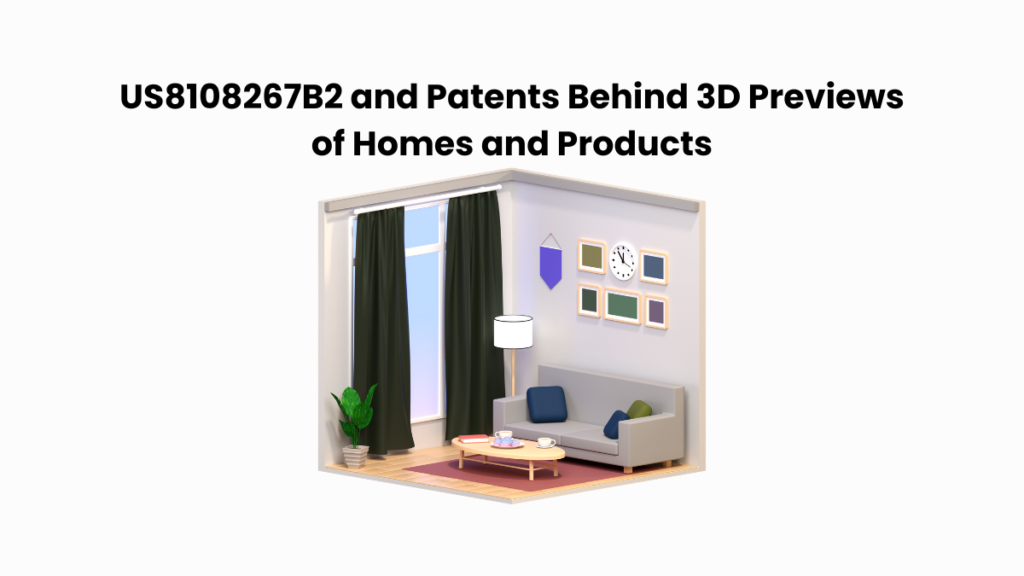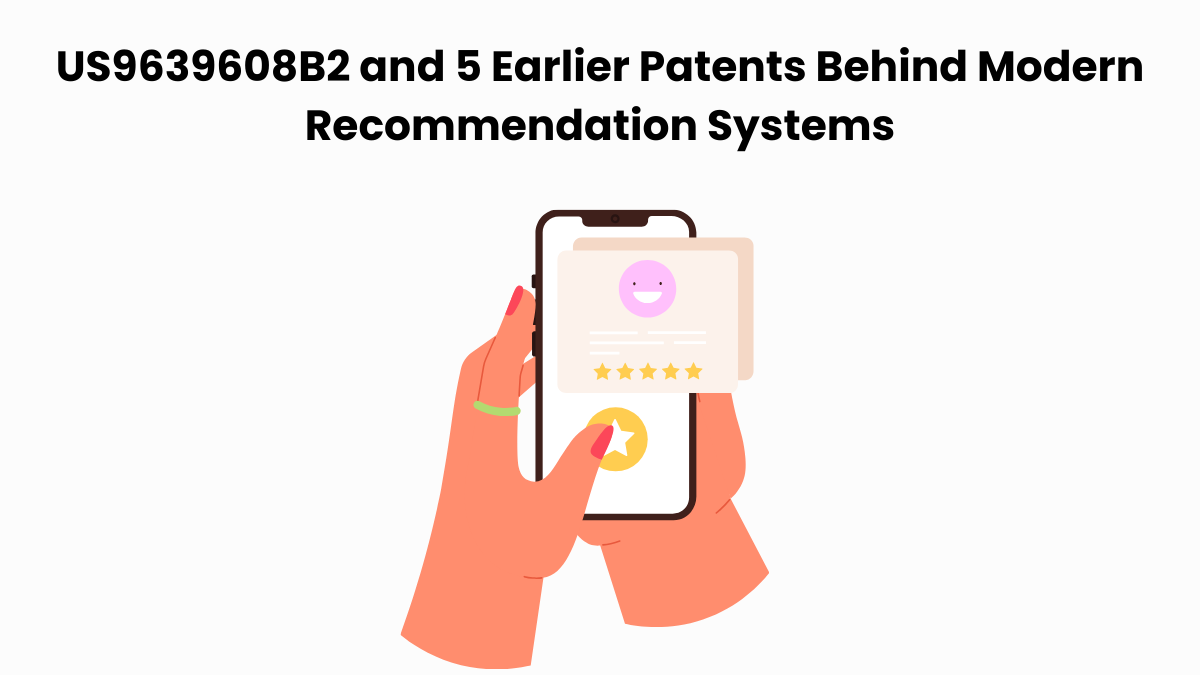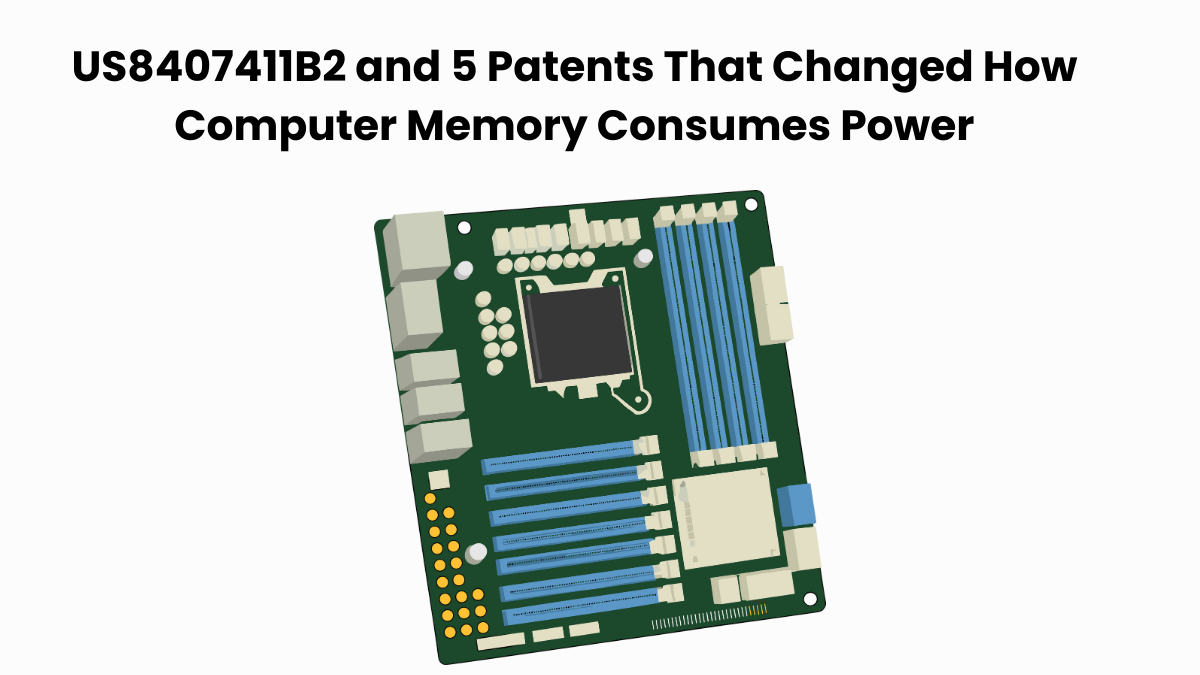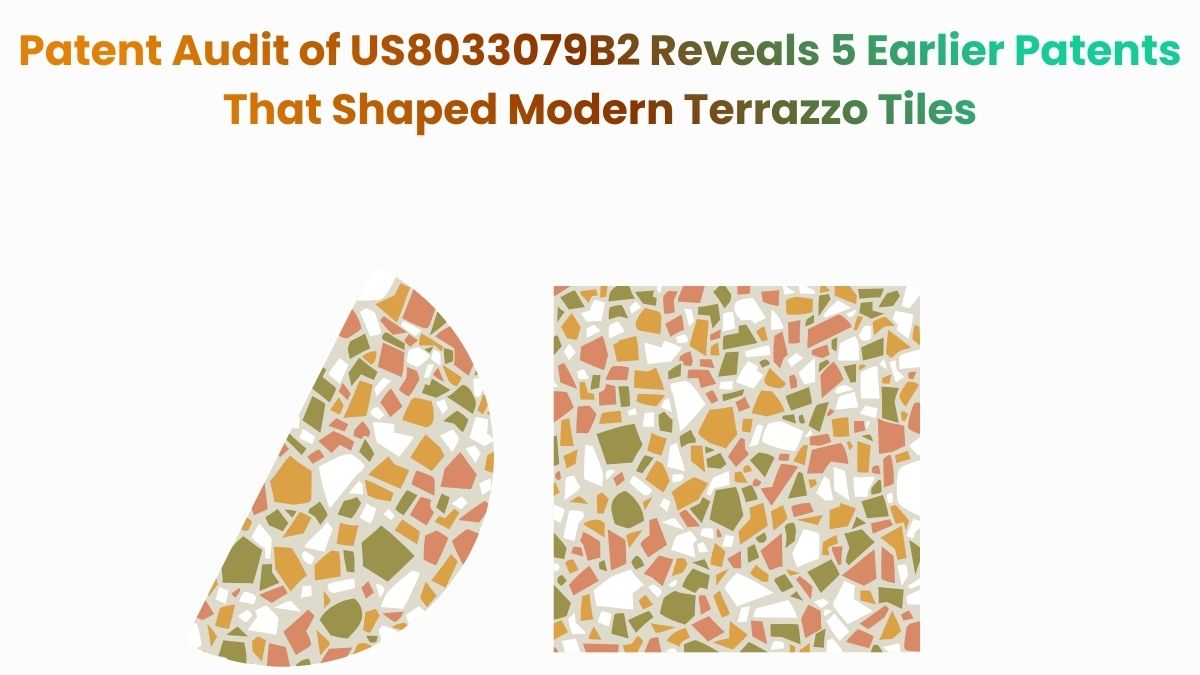Seeing a product on a flat screen rarely tells the whole story. A sofa may look perfect online, but feel wrong at home. A remodel might seem fine on paper, yet disappoint once built.
US8108267B2 changes that. The patent uses immersive 3D scenes to let people walk through rooms, swap finishes, and test ideas before buying or building. While it is central to the PanoVision LLC v. Panoee Corp. infringement lawsuit, our focus here is on the technology.
In this article, we will explore similar patents to US8108267B2 to learn more about the tech landscape. Using the Global Patent Search (GPS) tool, we will trace these innovations and see how they shape the future of immersive design systems.
Understanding Patent US8108267B2
Simply put, US8108267B2 introduces a method of facilitating sales through immersive 3D visualization. The invention allows users to preview products, services, or properties inside lifelike digital scenes before committing. Simulating real environments helps customers explore options from multiple viewpoints and reduces the risks of dissatisfaction after purchase or construction.
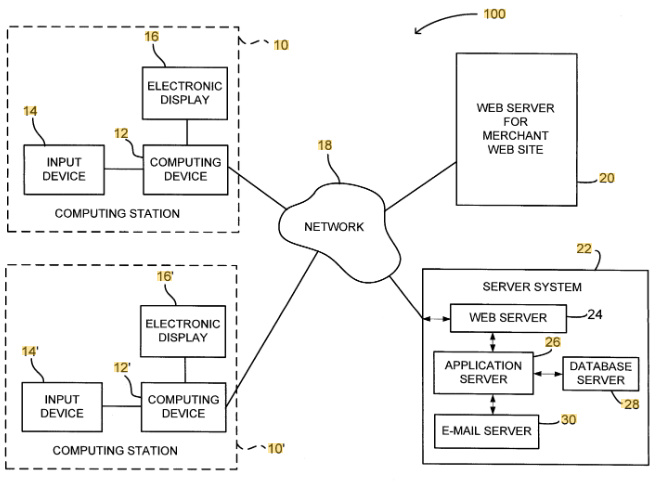
Source: Google Patents
The Key Features Of This Patent Are:
1. Immersive property and product viewing: Users see lifelike 3D scenes resembling actual spaces.
2. Seamless navigation: Movement between rooms and perspectives mimics real-world exploration.
3. Editable features: Walls, ceilings, floors, and furnishings can be added, removed, or modified.
4. Ranking system: Users can prioritize properties or product combinations based on preferences.
In addition, the patent describes further capabilities that expand its value. Scenes can be built from templates or exact dimensions with photos. Users can customize products, compare multiple options, and add items to a shopping cart with price and installation estimates.
Sellers and buyers may need inspections, valuations, or loan pre-qualification before use. The system also generates sales leads, offers incentives, and collects usage statistics to improve marketing and inventory management.
This level of interactivity aligns with US9965237B2’s approach to interactive display control, where dynamic user input transforms the experience of navigating digital environments.
Similar Patents To US8108267B2
To explore the immersive visualization ideas behind US8108267B2, we used the Global Patent Search tool to find similar patents. These references focus on 3D scene generation, product placement in real or virtual spaces, and photorealistic rendering across networks. Each highlights a different way digital imaging can influence purchasing decisions and property design.
1. US2002093538A1
This U.S. patent application US2002093538A1, published in 2002, introduces a system for composing and displaying 3D product images within realistic scenes. It allows users to select, position, and view objects such as furniture in a room, even before they are manufactured.
The system uses a client-server approach, where local computers create quick previews and powerful servers handle photorealistic rendering. This setup makes it possible to deliver lifelike images that support both consumer purchasing and professional advertising.
Below, we have added snapshots from the GPS tool showing the relevant snippets from the specification for similar patents.
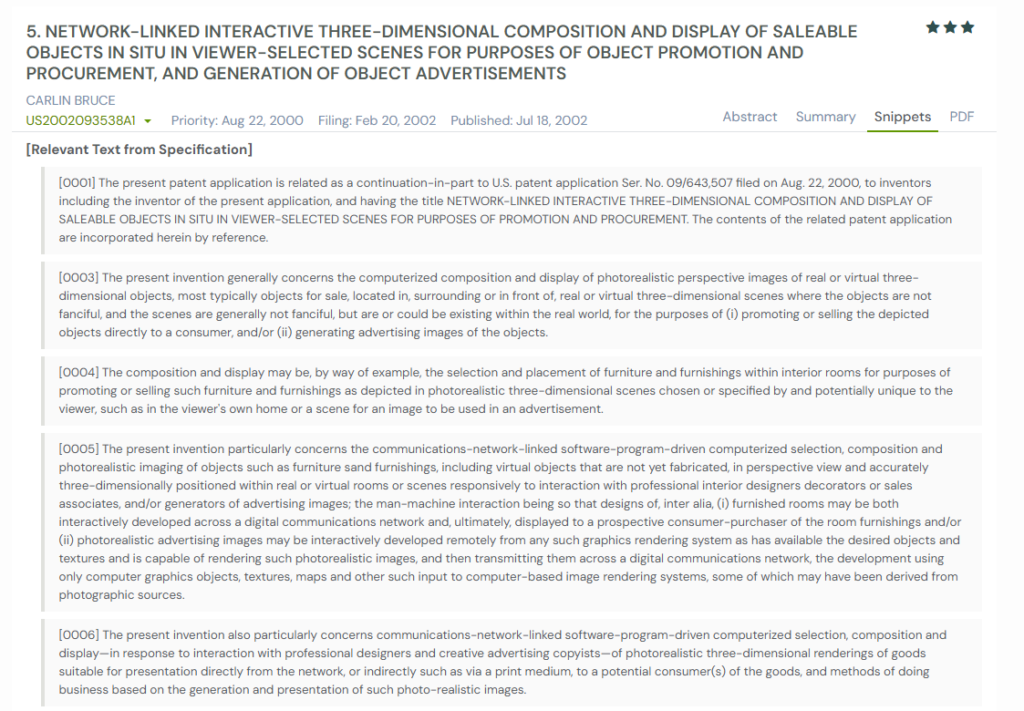
What This Patent Introduces To The Landscape
- A computerized system for the realistic placement of products in 3D rooms and scenes.
- Support for both real and virtual objects, including designs not yet fabricated.
- Client-server rendering with low-resolution previews and high-resolution final images.
- Applications for advertising, interior design, and product promotion.
- Secure server-side storage of high-resolution models and textures.
How It Connects To US8108267B2
- Both patents help users preview how products or changes will look before making decisions.
- US2002093538A1 emphasizes photorealistic rendering, while US8108267B2 focuses on immersive walkthroughs.
- Each enhances consumer confidence by simulating real-world appearances.
- Together, they show the evolution of visualization tools for sales and design.
Why This Matters
This patent highlights how 3D visualization supports commerce by turning abstract concepts into lifelike images. Its networked rendering approach complements US8108267B2’s immersive scenes, showing how visualization technologies can reduce uncertainty and improve decision-making.
Recommended Read: While 3D visualization helps users imagine spaces, innovations like the rotating magnetic connection system show how physical design can make real-world assembly just as seamless as virtual walkthroughs.
2. CA2735680A1
This Canadian patent application, CA2735680A1, published in 2009, presents an online shopping system powered by 3D reconstruction. It allows users to rebuild a virtual version of their home or office using photos or videos, then place new furniture or products into that reconstructed environment. The platform integrates shopping, design, and social features, making it possible not only to visualize purchases but also to collaborate, share, and even order directly from merchants.
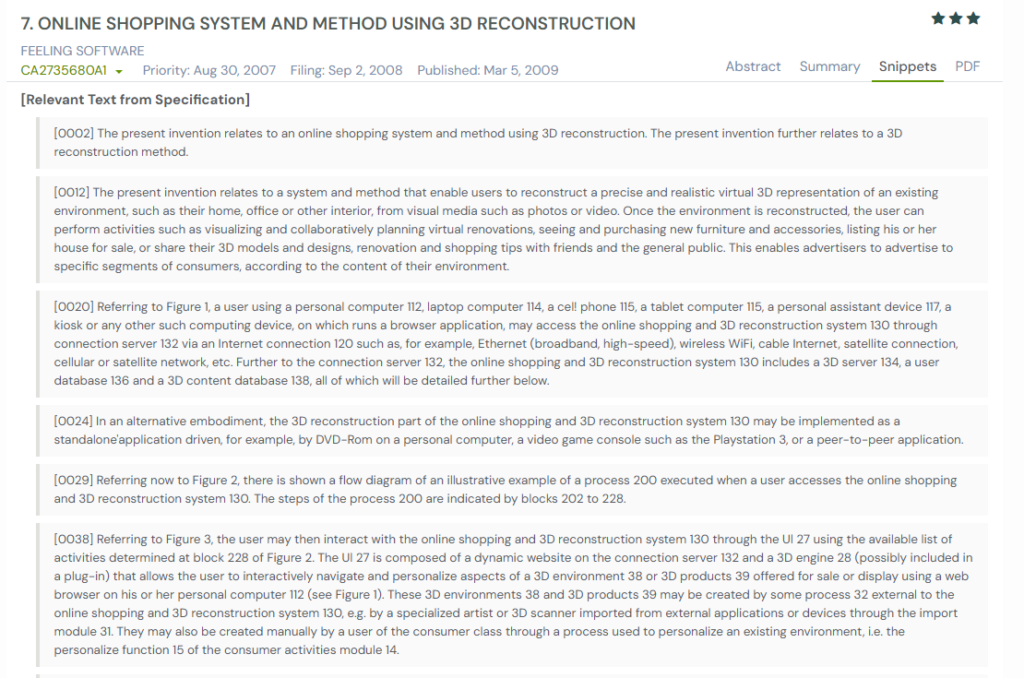
What This Patent Introduces To The Landscape
- Automatic 3D reconstruction of environments from photos or videos.
- Integration of shopping functions within personalized 3D spaces.
- Tools for personalization, such as color changes, layout adjustments, and lighting effects.
- Merchant integration with real-time product availability and pricing.
- Social and collaborative features for sharing environments and designs.
How It Connects To US8108267B2
- Both patents aim to give users confidence by visualizing changes before purchase or renovation.
- CA2735680A1 focuses on reconstructing existing spaces, while US8108267B2 centers on immersive walkthroughs of new or modified properties.
- Each supports decision-making by combining design, visualization, and commercial activity.
- Together, they highlight how 3D environments are used to merge shopping and planning.
Why This Matters
This patent shows how 3D reconstruction can transform online shopping into an interactive experience. By linking immersive design with direct purchasing, it complements US8108267B2’s emphasis on immersive scene viewing, creating a broader picture of how visualization drives consumer decisions.
You can also explore how other 3D visualization patents approach real-time depth enhancement in wearable displays in our analysis of US8108267B2 and related 3D visualization patents.
3. JP2001344479A
This Japanese patent application JP2001344479A, published in 2001, discloses a sales system that blends 3D room images with 3D product models. A server stores product data and returns 3D product information to a user’s terminal on request.
The terminal generates a 3D room from user inputs, composites the returned 3D product into that room, and lets the user move and rotate it to test placement. The design also supports workflows using recording media, so room data or product data can be carried between devices for in-store or at-home simulations.
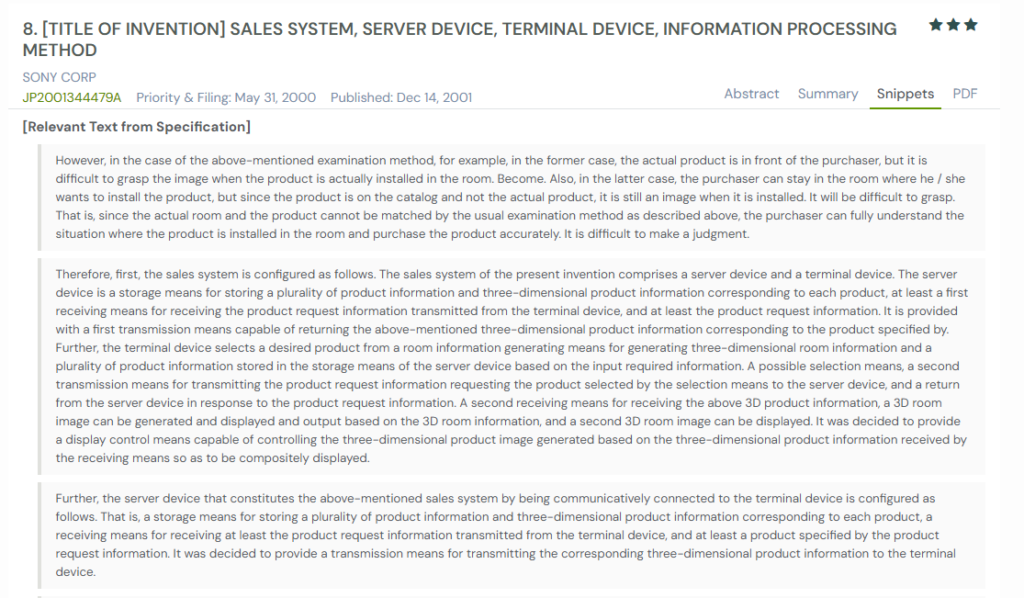
What This Patent Introduces To The Landscape
- Server–terminal system that returns 3D product data for local compositing in a 3D room.
- User-generated 3D room models can be created from simple inputs like dimensions and layout.
- Interactive placement and movement of 3D products within the room scene.
- Alternate workflows using recording media to shuttle room or product data between devices.
- Integrated purchase flow with billing after the user confirms selections.
How It Connects To US8108267B2
- Both aim to show products in realistic 3D rooms before purchase.
- JP2001344479A centers on server delivery of 3D product models and compositing.
- US8108267B2 emphasizes immersive walkthroughs and seamless room-to-room viewing.
- Each reduces uncertainty by letting users preview placement and configuration.
Why This Matters
This patent shows an early framework for mixing server-stored product models with user-built room scenes. Its media-based and networked workflows complement US8108267B2, underscoring how practical 3D previews can drive confident buying decisions.
4. US2005253840A1
This U.S. patent application US2005253840A1, published in 2005, introduces a method and system for interactive three-dimensional item display in e-commerce. It addresses the limits of static online product images by creating a software platform. Here, products from different vendors can be simulated, manipulated, and compared in 3D environments.
The invention allows products to be placed together, animated, and viewed from multiple perspectives, giving consumers a richer context for purchase decisions.
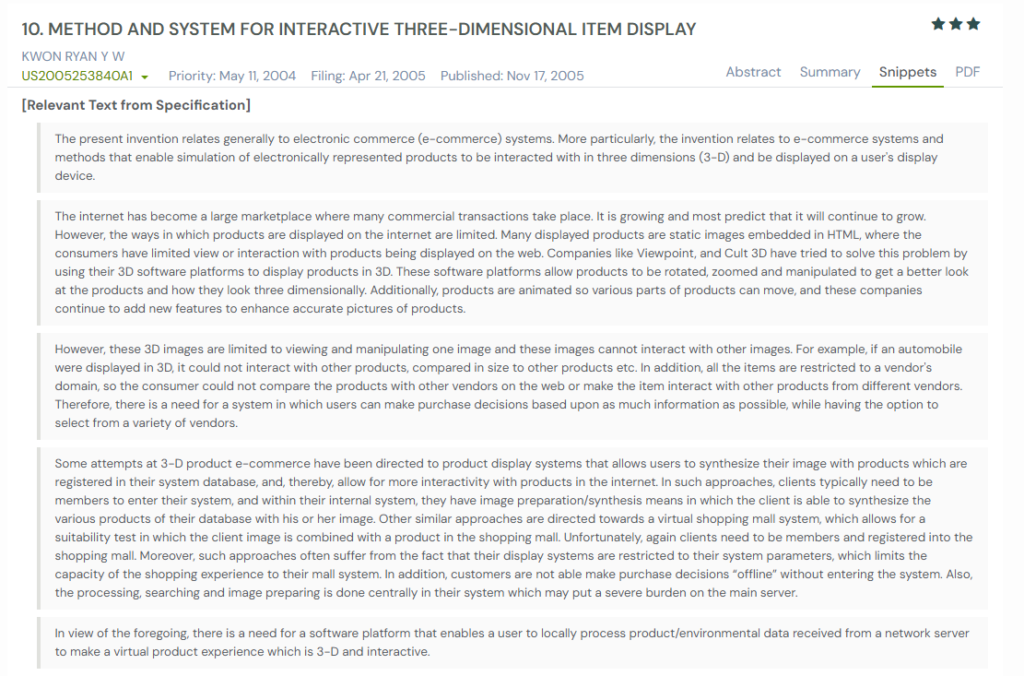
What This Patent Introduces To The Landscape
- A common software platform for interactive 3D product display.
- Compatibility for importing and converting 3D objects from multiple vendors.
- Realistic simulations including movement, placement, and physical interactions.
- Ability to co-locate products from different vendors in one virtual environment.
- Support for both vendor-created 3D virtual stores and consumer-customized 3D spaces.
How It Connects To US8108267B2
- Both inventions enhance online decision-making through immersive visualization.
- US2005253840A1 focuses on cross-vendor 3D interactivity, while US8108267B2 centers on immersive property walkthroughs.
- Each system enables realistic product placement and evaluation before purchase.
- Together, they show the shift from static catalogs to dynamic, interactive shopping experiences.
Why This Matters
This patent highlights how interactive 3D environments can bring e-commerce closer to real-world shopping. By enabling multi-vendor product integration and interactivity, it complements US8108267B2’s immersive walkthroughs, underscoring the broader trend toward experiential digital commerce.
5. ES2318989B1
This Spanish patent ES2318989B1, published in 2010, introduces an interior decoration system using augmented reality. It allows users to place virtual, life-size furniture into their real rooms using special visual markers. The furniture is selected from a digital catalog and appears overlaid in the user’s environment through a camera or smart glasses.
Users can rotate, resize, move, and re-texture each piece of furniture in real time. The system can run on computers, tablets, or even mobile phones, and supports both screen displays and head-mounted glasses.
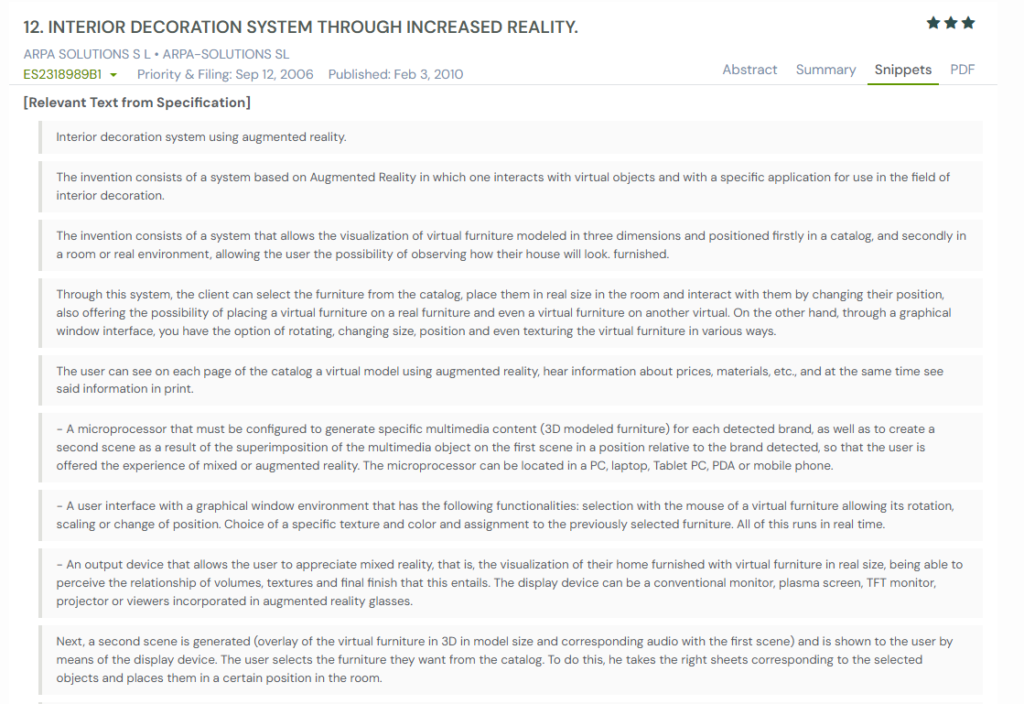
What This Patent Introduces To The Landscape
- Augmented reality furniture placement using printed markers.
- Real-time controls to rotate, resize, move, and change furniture textures.
- Catalog-based selection of 3D furniture models with visual and audio details.
- Output through regular monitors or head-mounted display glasses.
- Ability to place one virtual item on top of another or over real furniture.
- Adjustable transparency to better visualize overlaps or layering.
- Multimedia overlays including 3D models, audio, video, and images.
- Compatible with multiple devices like PCs, tablets, smartphones, and personal digital assistants.
How It Connects To US8108267B2
- Both systems let users preview products inside real spaces.
- US8108267B2 focuses on reconstructing entire indoor environments.
- ES2318989B1 places furniture models into real rooms using augmented reality.
- Both help users make purchase decisions by offering a realistic visual preview.
- They each offer flexible controls for furniture arrangement and customization.
Why This Matters
This invention helps users see exactly how furniture will look and fit in their space before buying. By combining visual accuracy with easy controls, it adds value to the shopping experience, just like US8108267B2, but with a focus on live, room-based interaction.
Related Read: US9549388B2 and similar patents solved how to navigate without constant internet by blending offline maps with live data. That same balance of efficiency and experience drives 3D imaging patents, which also make digital views smarter and more practical.
How To Find Similar Patents Using Global Patent Search
Studying similar patents helps clarify how others have tackled similar challenges in indoor mapping, virtual product display, and user interaction. The Global Patent Search (GPS) tool makes this process faster by surfacing patents that overlap in both concept and application.

1. Start with the patent number: Enter US8108267B2 into the GPS search bar. You can refine your results by adding keywords like “3D reconstruction,” “virtual shopping,” or “interactive environments.”
2. Scan key excerpts: GPS shows short, relevant passages from each patent it finds. These can highlight features like object rendering, real-time personalization, or client-side data processing.
3. Compare technical strategies: Some systems emphasize browser-based navigation, while others focus on immersive virtual stores or hybrid 2D/3D layouts.
4. Watch for recurring features: Look for patents that allow item placement, integration from multiple vendors, or measurement-based visualization, common themes across virtual shopping platforms.
5. Trace the direction of innovation: Reviewing similar filings reveals how digital shopping tools have evolved, from static webpages to dynamic, interactive systems that mimic real-world behavior.
The Global Patent Search makes it easy to find similar patents and see how they tackle similar problems. It highlights design choices, technical improvements, and different use cases. For a patent like US8108267B2, it helps you study what came before and what’s been done differently.
To get the most out of your searches, it also helps to understand the top features of an AI-powered patent search tool, which can speed up discovery and improve the relevance of results.
Disclaimer: The information provided in this article is for informational purposes only and should not be considered legal advice. The related patent references mentioned are preliminary results from the Global Patent Search tool and do not guarantee legal significance. For a comprehensive related patent analysis, we recommend conducting a detailed search using GPS or consulting a patent attorney.

